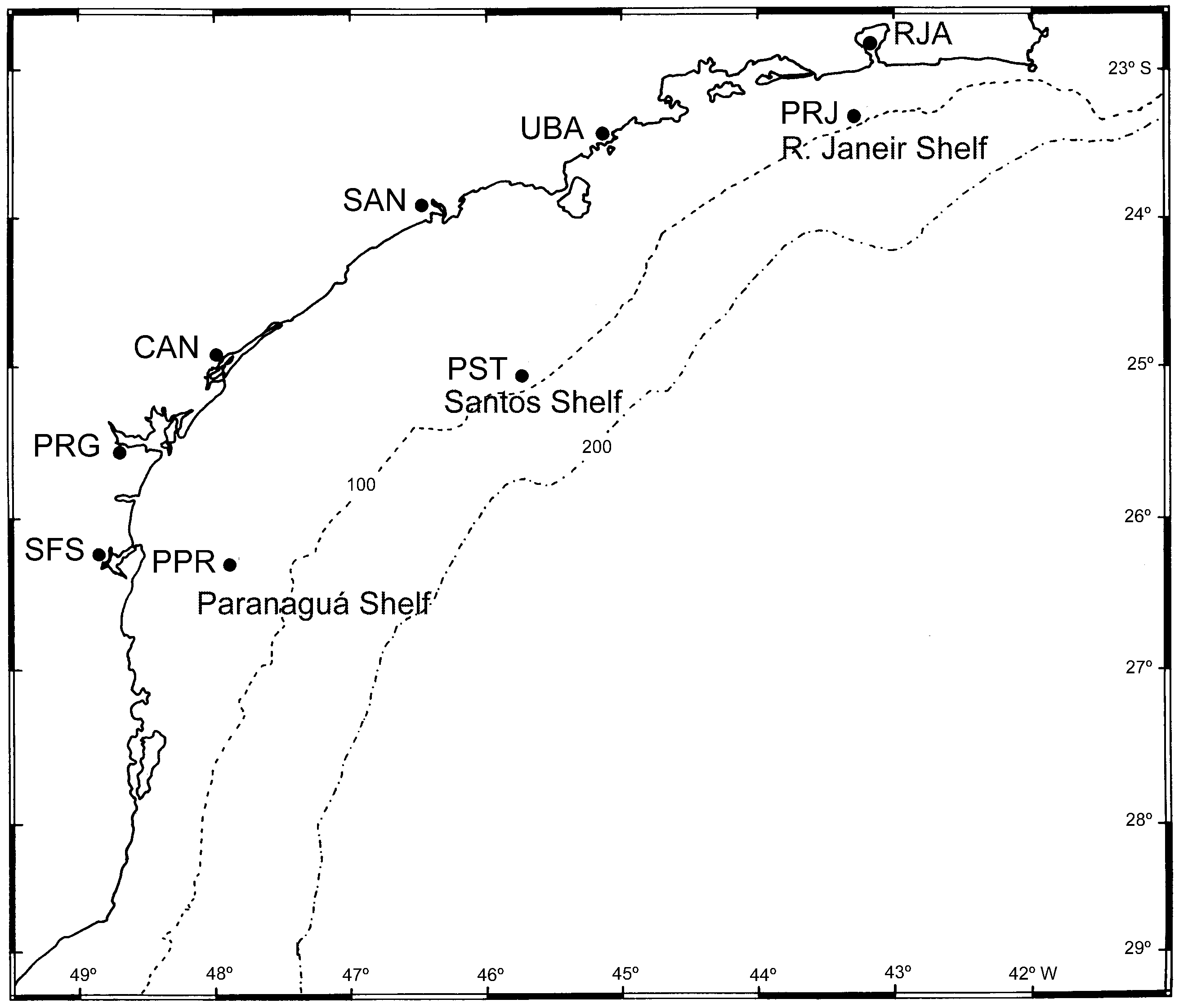
Figure 1 -The South Eastern Brazilian Shelf - PRJ , PST, PPR indicate the locations of the non permanent stations of measurements of tidalheights. UBA, SAN, CAN, PRG, are locations where there are permanent stationsof tides.
A R DE MESQUITA AND J HARARI
INTRODUCTION
During the period 1976-1981 the NOc Prof. W. Besnard, from the University of São Paulo , Brazil, under the research project named "Hidrodinâmica Costeira", (Coastal Hydrodynamics) funded by the "Financiadora de Estudos e Projetos" - FINEP, of the Brazilian Presidency of Republic, took several time series of oceanographic and meteorological variables in the Southern Coast of the Brazilian Shelf (Figure 1). General accounts of the above cruises are presented in Mesquita (1983, 1994 and 1998).
The general circulation of the area (PST, Santos Platform, PPR, Paranaguá Platform, and PRJ, Rio de Janeiro Platform) was object of study and estimation via the distribution of temperature, salinity and density by Emilson (1961) and Mesquita, Leite & Rizzo (1989), where a general overview of currents surface distribution on the Shelf can be found. First direct measurementof currents were made by Johannessen (1968), with Eckman current meters,in four fixed stations along the continental Shelf, for short periods (2 days time series), on board the NOc. Alte. Saldanha from the Brazilian Navy.
Hutnance (1980), who interpreted the world`s highest values of the M3 that occur in the area caused by the extension of the shelf, as a local resonant effect gave first account on the propagation of tidal heights. Present account gives the harmonic constants of the principal constituents of tides and tidal currents of the Shelf , a description of the circulation of currents, a discussion on the propagation of the tidal constituents,and their relationship with the vertical and horizontal distributions of tidal ellipses components and with the general circulation of the area.

Figure 1 -The South Eastern Brazilian Shelf - PRJ , PST, PPR indicate the locations of the non permanent stations of measurements of tidalheights. UBA, SAN, CAN, PRG, are locations where there are permanent stationsof tides.
MATERIAL AND METHODS
The South-Eastern Coast of the Brazilian Shelf area is shown in Fig 1, with the mapped locations of the ports, where there are permanent stations of tidal observations and the pelagic sites on the Shelf. In Tab. 2 are shown the values of Tidal Constants of the main tidal heights constituents determined for the ports of Rio de Janeiro, Ubatuba and Cananéia and the PRJ, PST and PPR geographical positions shown in Fig 1.
The dates of the cruises and the characteristics of the time seriesof the Pelagic Tides and currents obtained are shown in Table 1. Formore about the measurements see Mesquita (1983), Mesquita, Leite & Rizzo(1989) and Mesquita & Harari (2000). The analysis of tidal data were made via the Harmonic Method (Franco, 1971) and for measurements of currents by the Response Method ( Munk & Cartwright, 1966). Tab. 2 gives the tidal constants of the tidal heights for the permanent stations of the main ports of the area, such as Rio de Janeiro, Ubatuba, Santos, Cananéia, Paranaguá, São Francisco do Sul and Imbituba, which are nominated respectively as RJA, UBA, SAN, CAN, PRG, SFS and IMB.
The Pelagic non permanent stations on the Continental Shelf were nominated as PRJ (Platform of Rio de Janeiro), PST (Platform of Santos), PPR (Platform of Paranaguá) and PSC (Platform of Santa Catarina). Results for the Pelagic tidal constants are also reported in IAPSO'S Committee Report no 2, Cartwright & Zetler (1985) and Smithson (1992).
| Station Name | Plataforma de Santos | Plataforma do Rio de Janeiro | Plataforma do Paraná |
Plataforma de Paranaguá |
| Latitude (S) | 25º 1,0' | 23º 23,0' | 26º 7,4' | 26º 18,1' |
| Longitude (W) | 45º 42,0' | 43º 17,0' | 47º 39,4' | 47º 30,4' |
| Depht (m) | 92 | 100 | 60 | 74 |
| Beginning and end times of the tidal record |
22/07/1977 12:00 to 04/08/1977 10:15 (GMT) |
21/07/1978 12:30 to 21/08/1978 18:15 (GMT) | - | 18/06/1981 07:53 to 17/07/1981 07:38 (GMT) |
| Extension of the tidal record (days) | 12,9 | 31 | 29,0 | |
| Sampling interval (min) | 15 | 15 | 15 | |
| Beginning and end times of the current meter observations | 21/07/1977 22:00 to 03/08/1977 02:00 (GMT) |
22/07/1978 2:00 to 3/08/1978 15:00 (GMT) |
29/11/1980 12:30 to 12/12/1980 09:30 (GMT) | - |
|
Extension of the current meter observations (days) |
12,3 | 13 | 12,9 | |
| Sampling interval (hours) | 4 | 1 | 1 | |
|
Current meter Sampling depths (m) |
05, 15, 30, 40 | 00-10, 20-30, 40-50, 60-70, 80-90 | 05-10, 20-30, 40-50 |
Table 1 - The program of measurements of tidal heights and currents.
|
|
|
|
|
|
|
|||||||
| amp | phase | amp | phase | amp | phase | amp | phase | amp | phase | amp | phase | |
| RIO | 3.0 | 105.2 | 10.8 | 127.5 | 5.9 | 184.4 | 31.6 | 162.0 | 17.2 | 166.4 | 0.6 | 302.6 |
| UBA | 2.4 | 103.4 | 11.0 | 125.6 | 6.0 | 185.8 | 29.8 | 164.4 | 17.4 | 172.9 | 1.2 | 325.0 |
| SAN | 3.1 | 92.7 | 11.2 | 121.6 | 6.5 | 186.3 | 36.4 | 171.7 | 22.6 | 178.8 | 5.4 | 3.3 |
| CAN | 2.4 | 106.5 | 11.4 | 125.6 | 6.5 | 190.8 | 36.8 | 180.2 | 23.9 | 184.5 | 6.7 | 3.8 |
| PRG | 3.6 | 106.2 | 11.9 | 129.9 | 7.3 | 189.9 | 45.9 | 193.7 | 30.0 | 198.6 | 15.4 | 52.8 |
| SFS | 0.0 | 0.0 | 6.8 | 124.6 | 3.4 | 182.7 | 21.1 | 136.1 | 14.4 | 126.3 | 5.8 | 301.7 |
| IMB | 0.9 | 93.9 | 3.6 | 113.9 | 2.1 | 176.9 | 4.4 | 148.9 | 3.4 | 145.8 | 0.0 | 0.0 |
| PRJ | 2.7 | 102.4 | 9.4 | 124.7 | 6.0 | 191.0 | 25.4 | 160.5 | 14.3 | 167.7 | 0.6 | 201.3 |
| PST | 2.9 | 101.9 | 10.7 | 122.1 | 4.8 | 199.5 | 22.5 | 162.7 | 15.2 | 179.8 | 2.0 | 349.6 |
| PPR | 3.3 | 95.9 | 10.8 | 114.8 | 6.6 | 179.3 | 24.6 | 157.3 | 16.0 | 158.3 | 4.1 | 302.5 |
| PSC | 2.6 | 75.6 | 10.8 | 105.0 | 6.2 | 166.0 | 12.1 | 145.3 | 8.3 | 138.8 | 0.8 | 262.9 |
Table 2 - Tidal constants of the main tidal components of the South Eastern Brazilian Shelf at PRJ, PST and PPR (Non Permanent Stations) and RIO, UBA, CAN and PRN (Permanent Stations).
RESULTS
- Propagation of tidal heights- Inspection of phases of Tab. 2 shows that semidiurnals heights constituents M2, N2 , K 2, and S2 have an anti clockwise propagation from PRJ to PST and a clockwise one between PRJ and PST. Their amplitudes show a general increase from East to West, being higher near the port of Paranaguá and then decrease .Among the diurnals the Q1 and O1 , propagate from IMB to RJA in a West to East clockwise propagation, while K1 and P1 propagation follow approximately the semidiurnals components M2, S2, N2, K 2 and have also higher amplitudes near Paranaguá / Cananéia propagating clockwise from IMB and PSC to PPR (not shown) and anti-clockwise from Rio to Paranaguá.
Such opposite senses of propagation also suggest that the K1 has two amphidromes in the South Atlantic, one propagating clockwise and the other anti clockwise. The M3 has higher amplitudes,as the semi-diurnals, along the Paranaguá Shelf compared to the otherstations. The phases of M3 in the area do not seem to be elucidative, as do as well, any interpretation of the propagation behavior of higher order components, such as quarter diurnals M4, MS4 and othersnot mentioned.
-The main tidal currents constituents -.
O1 : At the surface (0 to 40m), the current vector rotates also anti clockwise,in all stations, as well as in the whole column of PPR, but not PRJ, where the rotation at 20m and below 40mis clockwise.In PST, Fig 3.1, values of HM are quite large and nearly constant, while the values of Hm decrease with depth. In PRJ, HM and Hm are large at the surface, with significant variation at intermediate depths, but nearly constant below 60m. In PPR, excepting the bottom ( where they are very small), the values of HM and Hm are large , with small variability, showing a maximum at 20m. In PPR, the eccentricity of the ellipses is also near to 1 Assuming the eccentricity as given by the ratio of the minor and major axes.
In general, the angles of the major axes relative to the E-W axis for the O 1 tidal currents ellipses are similar to those of Q1 and appear to have a counter-clockwise rotation along the depth, varying from SW- NE at the surface to nearly S-N- SE-NW from 30 to 50 m depth to nearly E -W, from 60 to 90 m depths. The inclinations of the O1ellipses of are similar to those of Q1 and the comparison also can be made by the values of (M) that, except for differences in rotation at mid depth in PPR, are all similar as expected, bearing in mind the Rayleigh´s criterion.
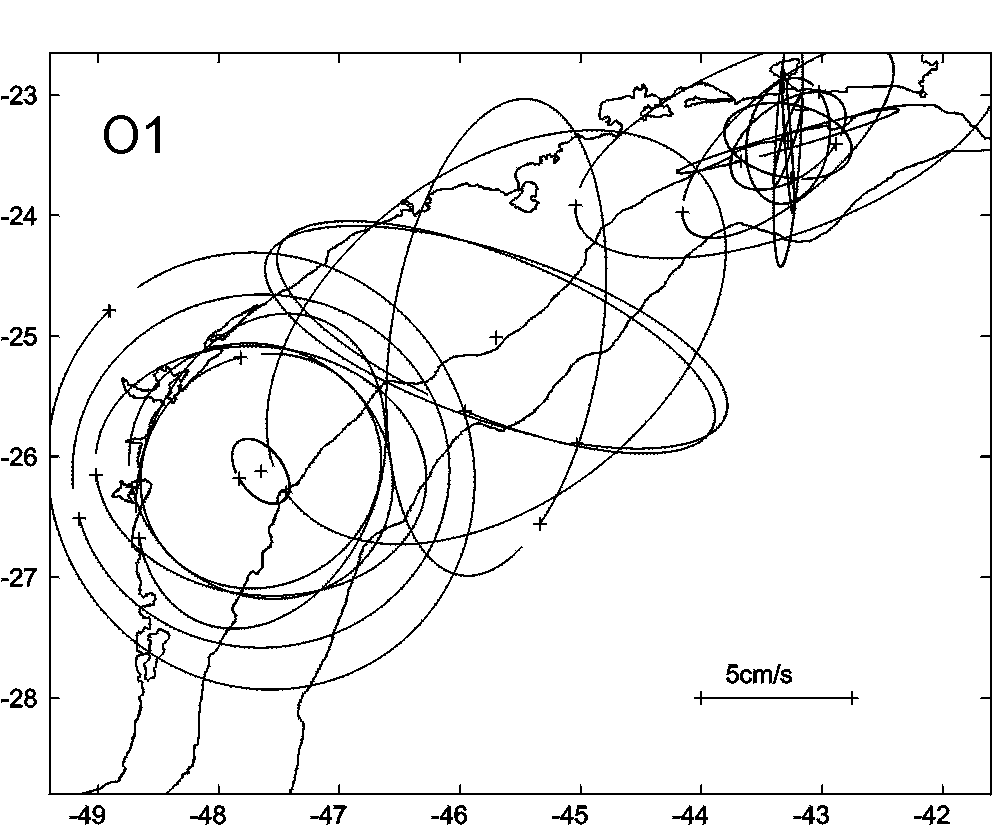
Figure 3.1 Superposed ellipses of O1 currents for the main tidal components of the South Eastern Brazilian Shelf at the locations of PRJ, PST and PPR indicating their general counter-clockwise rotation.
K1 : At the surface layer (5 to 40 m) the currents vector rotates also counter-clockwisein all stations and the same is observed at all deeper layers of PPR (60m) and PRJ (90m), with only two exceptions in PRJ, at 60 and 80 meters. In PSTthe ellipses (Fig 3.2), values ofHm and HM at 5 and 15 m are the strongest among all the constituents in that station. The same occurs in PRJ, where the value of HM of K1 at5m is the strongest among all the tidal currents constituents in all Southern Brazilian Shelf, reaching 11. 1 cm/s. In PPR the value of HM at 5 m is large, but comparatively smaller than in other stations.
For all stations PPR, PSTand PRJ the ellipse values of HM and Hm decrease substantially towards the bottom . In all three stations, values of (alpha M) of the inclination of the ellipses of currents in all depths indicate a rotation of the major axis, especially at the surface, from W- E to SW-NE to S -N andSE-NW approximately, similarly for the P1 major axes, as one goes from PRJ to PPR (Fig 5b). Similar ellipse variability of directionsis also shown by P1 as expected.
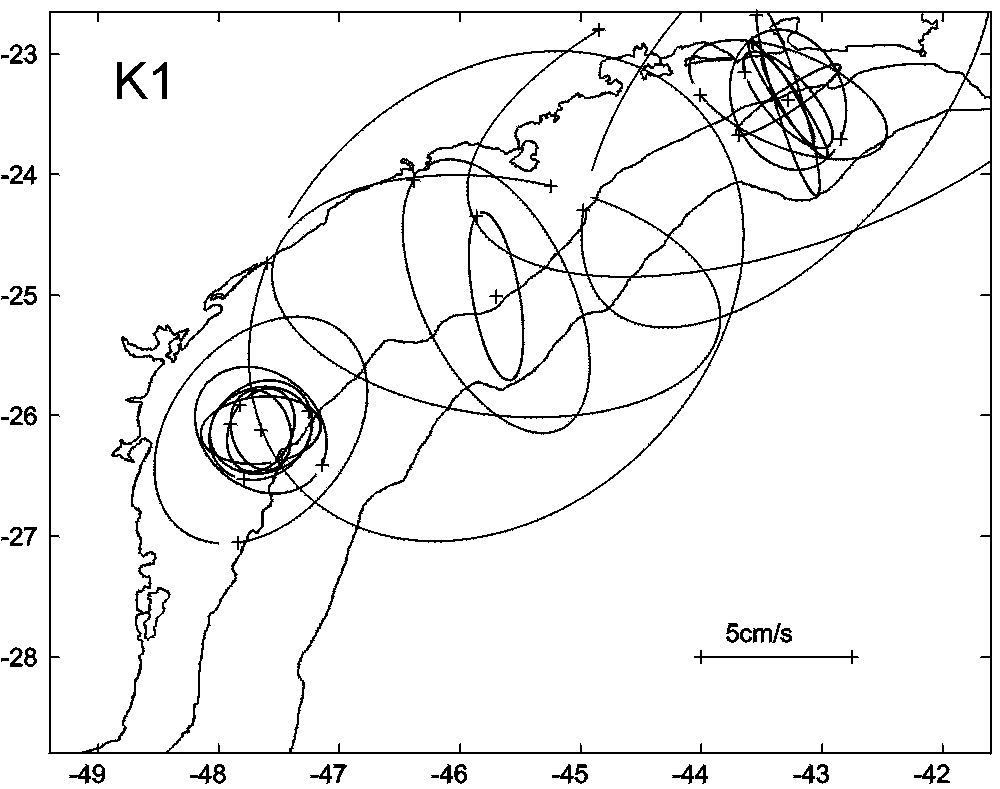
Figure 3.2 Superposed ellipses of K1 currents for the main tidal components of the South Eastern Brazilian Shelf at the locations of PRJ, PST and PPR indicating their general counter-clockwise rotation.
M2 : At the surface (5 to 40m) of PST, (Fig3.3), the currents vector rotates anti clockwise, while in PRJ rotation is in both directions along the depth and in PPR rotation is also anti clockwise. From 40m to the bottom, in PRJ and PPR, M2 also rotates anticlockwise, with the only exception at the depth of 40m of PPR. The values of HM and Hm indicate strong M2 currents in PST and PPR, being the strongest in PPR (maximum of 7.5 cm/s, at20m). These currents are fairly weak in PRJ,which showed in the column, however,higher values of currents at the bottom layer, 80 to 90 m.
A general feature is the small HM variability of the maximum and minimum values along the vertical, being almost constant along the depth in all sites. Directions of the ellipses, given by the (alphaM) are nearly the same in PPR, along the vertical profile, being nearly NW-SE in all the depths of observation of currents. The same is seen in the PRJ, only approximately, as the ellipses have a nearly W-E orientation of (alphaM). Orientation of ellipses in PST is nearly NW-SE from surface to 20m and exactly E-W at 30 m, turning to almost NW-SE direction at 40 m.
It is remarkable the small variation of the M2 ellipses inclination ( alpha ) in PPR along the vertical, all being in the NW-SE direction (approximately); also noticeable is the inclination of the N2 ellipses that shows similar directions as those of the M2 at all depths of PPR,PST and PRJ. It is also remarkable that the bottom HM valuesof currentsat PPR (60m) andPRJ (90m) are higher than in all layers above.
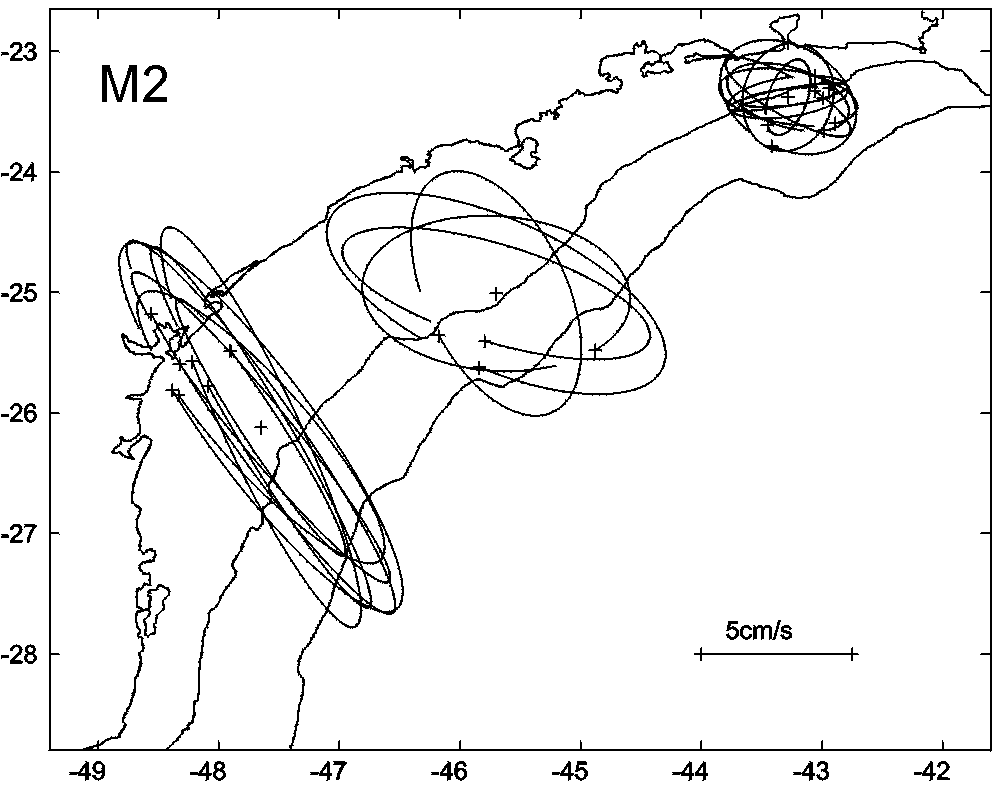
Figure 3.3 Superposed ellipses of currents for M2 the main tidal components of the South Eastern Brazilian Shelf at the locations of PRJ, PST and PPR indicating their general counter-clockwise rotation.
M3 : In PST, at the surface, the currents vector rotates clockwise 5m, (Fig. 3.4),and anti clockwise between 10 and 40m; in PRJ, there is a great deal of variabilityin the direction of rotation along the depth; and, in PPR, the rotation is mostly anti clockwise, except at 20 and 40m. The values of HM and Hm along the vertical, however, present relatively small variations, in all the three stations, but the directions of the currents ellipses as given by ( alpha M) vary along the depth.
Ellipses of the three sites seem to have retained the same general ( alphaM) values from surface to 30 m, they were almost similar between 40 to 60 m with different values ( alphaM) from the previous ones and from 70 to 90 m only in PRJ, where they showed inclination varying from NE to N in the bottom layer. It is also noticeable that the larger M3 values of the area occur at depths of 60 to 80 meters of PRJ. The ter-diurnal ellipses of currents, as the semi-diurnals, have each one similar amplitudes along the depth in each site and, except for the 5m layer, have also similar characteristics of amplitude HM and (alphaM) vertical distributions in all layers of each station
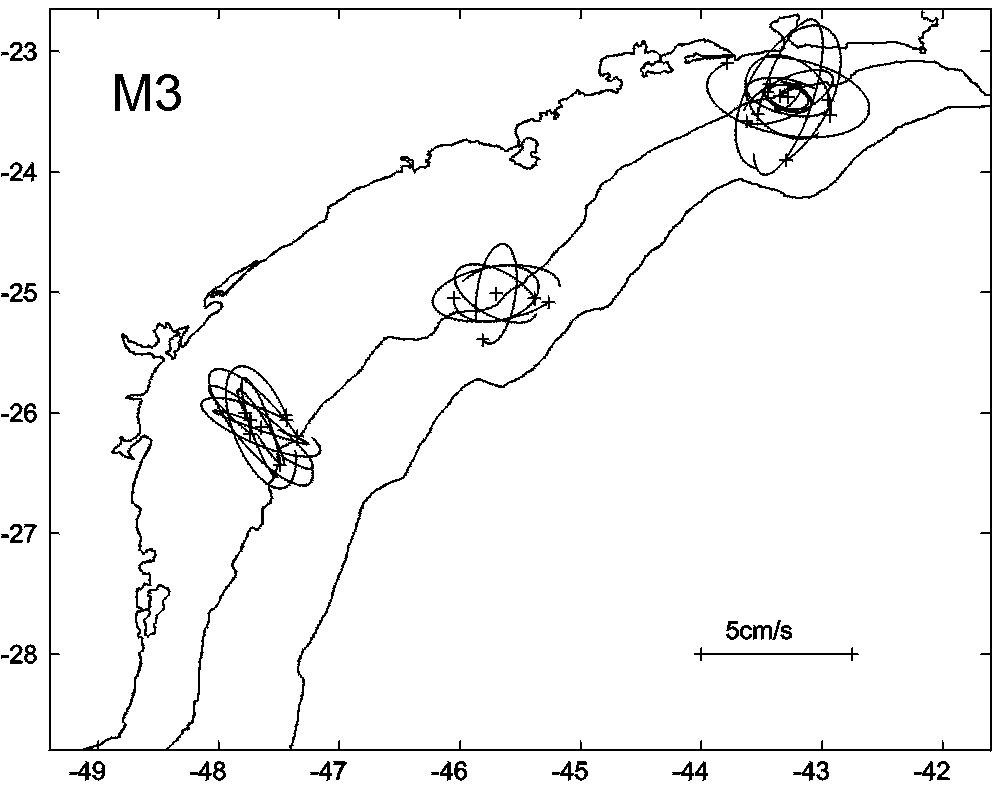
Figure 3.4 Superposed ellipses of currents for M3 the main tidal components of the South Eastern Brazilian Shelf at the locations of PRJ, PST and PPR indicating their general counter-clockwise rotation.
DISCUSSION AND CONCLUSIONS
- Tidal heights and induced tidal currents - The greatest values of the surface tidal currents of PST , O1 (8.67 cm/s) and K1 (7.4 cm/s) are induced by the diurnal heights constituents O 1 (10.1 cm) and K1, (5.9 cm), while the M2 tidal height with 21.3 cm and S2 with 14.7 cm are the dominant height components of tides,but produce smaller current components.
M2 : 6.05 cm/ sec and S:2.65 cm/sec. Similarly, in PPR the S 2 (17.4 cm), and M2 (24.4 cm) tidal heights produce currents components S2 (4.32 cm/s) and M2 (7.32 cm/s)nearly as energetic as O1 (6.25 cm/s) and K1 (4.23 cm/s) that are induced by the tidal heights O1 (10.8 cm) and K 1 (6.4 cm), that are smaller than the semidiurnals heights of M2 and S2.
Also tidal current components of PRJ (5 to 40m) are generally smaller but behave similarly as those of PST. Currents components O1 (7.4 cm/s) and K1 (11.1 cm/s) of PRJ are greater than the ones of M2 (1.3 cm/s) and S2 (2.9 cm/s), although the corresponding diurnal heights, O1 (9.7 cm) and K 1 (5.6 cm), are smaller than the semidiurnals heights M2 (24.1 cm) and S2 (15.4 cm) .
Other relation, mostly true for the surface layersof PRJ, is that the semi-diurnals heights M2 and S2 are greater than O1 and K1 , but the induced current components M2 and S2 are smaller than the currents induced by O1 and K1; that is, smaller diurnal heights O1 and K 1, induce greater diurnal amplitudes of currents, mostly at the surface, than the much higher heights of semidiurnal components, M2 and S2, induce semidiurnals currents.
At the bottom,the currentsof PPR and PRJ seem to be following accordingly, i.e., higher values of current components are associated with higher values of the corresponding components of tidal heights, as the diurnal amplitudes decrease towards the bottom and the semi-diurnals and the terdiurnal tend to preserve their surface values along the depth to 40m layer and tend to be come smaller with depth.
- The general characteristic - of the structure of the tidal currents is that the diurnal components of currents have greater amplitudes at the surface layers down to 40 meeters layer and then become smaller whit deeph. The semidiurnals currents, otherwise, have approximately constant amplitudes along the vertical profile, feature also followed by M 3 . The highest values of tidal heights constituents do not necessarily induce the highest values of currents components and the ellipses axes of diurnal tidal components tend to rotate counter-clockwise, from surface to the bottom, apparently following the hydrographic and meteorological forcing along the surface layer , the mid layer and the bottom layer.
At the bottom,the currents of PPR and PRJ seem to be following accordingly, i.e.,highest values of currents components are associated with highest values of the corresponding components of tidal heights, as the diurnal amplitudes of currents decrease towards the bottom and the semi-diurnals and the ter-diurnals tend to preserve their surfaces values along the depth. The height constituentsP1, K1, N2 , S2, K2 and M2 propagate counter-clockwise from PRJ to PSTand clockwisefromPPR to PST, suggesting two amphidromic systems for each of these constituents in the South Atlantic; on the other hand, constituents Q1 and O1 propagate clockwise, from PPR to PRJ.
For the principal diurnal constituents (Q1 , O1 , P1 and K1 ), the rotation of the currents vector at the surface, in the Southern Brazilian shelf, is counter-clockwise; however, in the Northern station (PRJ), below the surface layer, some clockwise rotation is observed, for all these tidal current constituents, probably due to increasing shear between the coastal currents and the Brazil Current, which may induce vortices with clockwise polarization in all tidal bands. This is also the case of the semidiurnal and ter-diurnal current constituents. The principal semi-diurnal current constituents (N 2, M2, S2, K2) and M3 have rotation which is counter-clockwise at the surface layer in PST,and vary along the vertical in PRJ, where these currents are normally very weak and mainly counter-clockwise, with a few exceptions, along the column.
At PPR and PRJ mid water, intrusion of the Tropical Water seems to have influenced the clockwise rotation of the semidiurnal constituents, (M2 and S2). The principal ter-diurnal current constituent (M3) presents a counter-clockwise rotation at the surface layer in PST(except at 5M), a variable rotation along the vertical in PRJ and is predominantly counter-clockwise in PPR (except 20 and 40m). The M3 ellipses do not exhibit large spatial variation of the intensity, both horizontally and vertically, as shown by the diurnal and semidiurnals tidal components.The important feature is relative to the surface currents, where they are predominantly diurnal, in PRJ, and have significant semidiurnals components in PST and PPR.
Diurnal currents are strong at the surface, but tend to decrease along
the depth,while semidiurnal and the M 3 currents, have approximately
the same values along the vertical. It appears also that the double sense
of propagation of the tidal heights, as indicated by the phases of the
tidal constituents, are related to the South Atlantic amphidromes
of the M2 constituents, which induce intermixed clockwise and
counterclockwise tidal currents in the water columns. Further aspects of
the tidal forcing exhibited by different responses of water masses of the
region (Coastal Water,Shelf Water Tropical Water and Subtropical Water)
are shown in Mesquita & Harari (2000), that can be found at UNESCO
e-library http://ioc.unesco.org/iocweb/iocpub/iocpdf/w171.pdf
ACKNOWLEDGMENTS
We are grateful to FINEP ( Financiadora de Estudos e Projetos) of the Presidency of the Republic of Brazil, to FAPESP (Fundação de Amparo à Pesquisa do Estado de São Paulo ) and to the British Council , UK.
REFERENCES
- Cartwright D E & Zetler B D, (1985). Pelagic Tidal Constants.
IAPSO Scientific Publication No 33. 1-53.
- Emilson I . (1961). The Shelf and coastal waters off southern
Brazil. Bolm. Inst. oceanogr. , S Paulo. 11 ( 2 ) : 101 - 112.
- Franco, A S & Rock, N J . (1971). The fast Fourier transformand
its application to tidal oscillation. Bolm. Inst,. oceanogr. Univ. S.Paulo.
SP.
- Franco, A S dos & Mesquita, A R de (1986).
On the Practical use in Hydrography of Filtered daily values
- Hutnance, J. M, (1980). On shelf "resonance" with application to
Brazilian M3 tides. Deep - Sea research, Vol. 27 A : 347-366.
- Johannessen O. M. 1968. Note on some hydrographical and current observations
from three positions on the Brazilian shelf in the region of Cabo Frio
-Santos 1966. Contrições Inst. oceanogr. Univ. S Paulo, ser.
oceanogr. fis., 10 : 1 - 8.
-Mesquita A R de & Harari J (1983). Tides and Tide auges of Cananéia
and Ubatuba. Relat. int. Inst.oceanogr. Univ. S. Paulo. SP. (11) : 1 -
14
- Mesquita A R de (1983) . Contribuição à Oceanografia
da Região Costeira Sudeste do Brasil (Lat 24S) - Sub Projeto Hidrodinâmica
Costeira : Execução e Resultados. Thesis of Livre Docência
presented to the Instituto Ocenografico da Universidade de São
Paulo. SP. 187
- Mesquita A R de (1994) .Variação do nível
do mar de longo termo. Inst. est. Avanç. Univ. S Paulo. SP. Documentos
- Série Ciências Ambientais. Vol ( 20 ) : 47 - 67.
-Mesquita, A R de (1998). O programa IOUSP para o Global Changes :
Origem e Contribuições. Apresentado no Seminário Ciência
e Desenvolvimento Sustentável. Inst. est. Avaç. Univ. S Paulo.
SP. A aparecer. 25 p.
-Mesquita, A R de &Harari, J (1999) . Propagation of Tides and
Circulation of Tidal Currentson the South - Eastern Brazilian Shelf.
Afro-America GLOSSNews. Vol3(2) : 2-8.
- Mesquita, A R de & Harari, J. (2000). On the sea level
network and circulation in the south-eastern Brazilian Coast. In Ocean
circulation science derived from Atlantic, Indian and Arctic sea level
networks. Editor: Gary Mitchum. IOC-WR 171-Annex III : 34-63.
- Munk, W. H. & Cartwright , D. E. (1966).
Tidal Spectroscopy and prediction. Phil. trans. Roy. Soc., SA, Mathematical
and Physical Sciences. n 1105, Vol ( 259 ) : 533- 581
- Smithson, M J (1992). Pelagic Tidal Constants. IAPSO ( International
association for the Physical Sciences of the Oceans o the IUGG) 33 : 1
191.
- Spencer R & Gwiliam, TJ P. (1968). Sea bed capsule for
measuring pressure at depths up to 4000 metres. 1974. Proc. of IEEE. Inter.
Conf. Eng in the Ocean Environment. Vol (1) : 339-343.